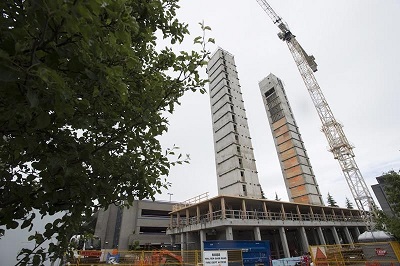 Friday, April 26, 2024
Friday, April 26, 2024  Friday, April 26, 2024
Friday, April 26, 2024 
Six years ago architect Michael Green took the stage at a TED conference and called for an global era of wood-framed skyscrapers.
Some were skeptical.
“People really thought I was an idiot,” said Green in a recent interview.
“I got constant comments from my peers just saying this guy didn’t know what he was talking about, this will never happen, the construction industry doesn’t change. And look at it now, it’s made a massive amount of change.”
Almost non-existent a decade ago, tall wood buildings have defied skeptics and are sprouting up in cities across Canada as the wood industry sees opportunity, developers embrace new designs and momentum builds to reduce the heavy carbon footprint of concrete and steel in construction as the urgency of the battle to combat climate change grows.
“For me it all comes back to the carbon story. It all comes back to choosing renewables to build our cities,” said Green, principal at Vancouver-based Michael Green Architecture.
Wood offers the benefit of being made of captured carbon and of reducing the need for concrete, which the International Energy Agency estimates is responsible for seven per cent of global greenhouse gas emissions.
But it was the housing market collapse a decade ago that helped prompt B.C. to start promoting the use of new timber building techniques already being used in Europe in an effort to boost the forestry sector.
The results include the Brock Commons tower on the University of British Columbia campus, the world’s tallest wood building at 18 storeys. The hybrid building has two concrete core pillars, but is still estimated to have captured 1,753 tonnes of carbon in the timber and prevented 679 tonnes of emissions, equivalent to taking more than 500 cars off the road for a year.
Building tall with wood has been made possible thanks to the use of both new and old techniques. Brock Commons used the relatively recent innovation of cross-laminated timber, which involves gluing perpendicular layers of lumber together to create reinforced sheets for the walls and floors. For pillars, it used the much older technique of gluing parallel pieces of lumber together to make thick beams.
Growth in tall wood buildings has been hampered by code limitations, but one-off exemptions mean several others are in the works even as the codes themselves are expected to soon change.
Watch the video and learn more about the benefits of joining Construction Links Network – the peer-to-peer network sharing platform for the construction, building and design community.
Ideal for YOUR Press Releases | Project Updates | New Appointments | Awards & Milestones | Company News | New Products/Services | Brochures | Videos | Infographics | Blog Sharing | Events and More